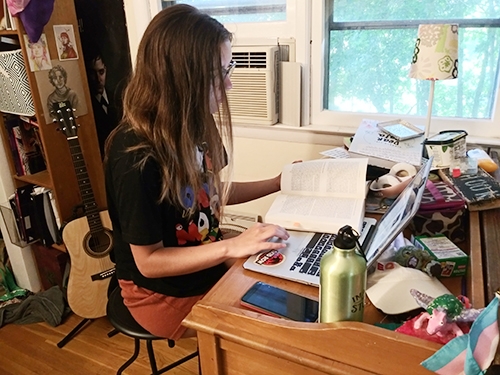During her time at Union, Mia Villeneuve ’22 has spent countless hours in the Ion-Beam Analysis Laboratory studying the content of lead and other heavy metals in New York City soil.
In performing proton-induced x-ray emission (PIXE) analysis on soil samples collected around the Hell Gate Bridge, Villeneuve discovered higher concentrations of lead and zinc than allowed under EPA standards. The concentrations originated from heavy metals in the paint used on the iconic railroad span between the Bronx and Queens.
A physics and theater major, Villeneuve hoped to continue her research in the lab this summer. Because the COVID-19 pandemic forced all summer research online, Villeneuve is doing research from her home in Croton-on-Hudson, N.Y., working remotely with Michael Vineyard, the Frank and Marie Louise Bailey Professor of Physics and Astronomy.
“It has been easy since I can do research online or request materials to be delivered through interlibrary loan,” said Villeneuve. “From my literature search I have found that lead in the soil can be transferred to the bloodstream through inhalation of dust or ingestion via hand-to-mouth pathways, which can then cause many adverse health effects, especially in children. We hope to come up with a method for remediating this problem in the future, and once we get back into the lab, we can perform more PIXE analysis.”
Villeneuve is among 86 students engaged in research this summer. Working with 56 faculty representing 21 departments and programs, the students are part of the collaborative scholarly activity that is a staple of a Union education.
Most projects are funded through the undergraduate research program. Government or scientific society grants to faculty members, academic departments and foundation funding support the rest.
A virtual poster session highlighting this year's projects went live Aug. 10.
“This has obviously been extremely challenging, with students not having access to labs and facilities that would normally be buzzing with activity at this time of year,” said Chad Orzel, the R. Gordon Gould Associate Professor of Physics and director of Undergraduate Research.
“I was amazed that we got as many students as we did - we're at about two-thirds of the usual number of summer researchers - but students and faculty really went above and beyond finding ways to convert projects from in-person to remote work. A couple of faculty have even asked to extend student projects beyond what they originally proposed because remote research is going better than they expected. Overall, it is a great testament to the ingenuity and dedication of our students and faculty.”
Andreina Negretti ’21 works on her project, “Drawing a Better World: Comics and Graphic Novels on Social Issues,” while staying in Miami, Fla., this summer. Aided by Stephanie Mueller, assistant professor of Spanish, Negretti is researching the impact of comics and graphic novels in Spain, Latin America and the Spanish-speaking U.S. to help with the creation of a new Spanish course at Union. Negretti is an international student from Lechería, Venezuela.
Her project includes weekly Zoom meetings, regular emails and frequent visits to Google Drive.
“It was necessary for us to plan ahead to make sure we were going to have the resources we needed on time, considering that most of these books are in Spanish and they are harder to locate,” said Negretti, a Latin American and Caribbean Studies major, with minors in French and Francophone Studies and Law and Humanities. “But with the help of staff from Schaffer Library, it wasn’t as complicated as one would have thought. It just required a bit more planning.”
While she would have preferred in-person research, she said her project remains engaging and meaningful.
“Despite the situation we are living right now with the pandemic, I don’t consider that my summer research experience was immensely affected,” she said. “Adjusting and being flexible were necessary, but the research component itself remained intact.”
Computer engineering major Jason D’Amico ’23 is working with Tomas Dvorak, professor of economics, and David Glasser, Enrollment and Operations director, to build a predictive model based on years of Union admissions data. The goal is to generate a model that can accurately predict the probability of enrollment for each applicant. This would help Admissions create an applying class's expected profile based on the information prospective students provide in their applications.
D’Amico meets remotely twice a week with Dvorak and Glasser from his home in Freeport, Maine. The three review his work, which includes preparing the data for analysis, working on code to develop predictive models and evaluating their performance.
“The remote transition was smooth,” D’Amico said. “Luckily, everything I needed to do for the project can be done on my laptop. Being in an academic setting on campus may have improved my focus on the project, but from a productivity standpoint, I think that the screen-sharing method makes it easier for them to follow my code than it would be if we were all huddled around a computer screen in person. I do not think that the remote setting has been a hazard at all relative to my project's potential.”
Check out the list of summer research students and their projects.
To learn more about undergraduate research at Union, visit the website.
